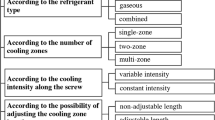Abstract
In the present article, the influence of the self-tapping screw’s geometry during the thread forming processes in polymer types used in several industries was studied and analysed using experimental measurement and the finite element method. A number of parameters, such as assembly, type of materials and geometry, were studied. Several commercial screw topologies were also studied, and it was demonstrated that the geometry of the self-tapping screws could be optimised. A new geometry was proposed and then compared against the commercial self-tapping screws. The proposed screw obtained a smaller installation torque and a greater stripping torque, which resulted in a greater clamp load in the self-tapping joining. The clamp load loss due to relaxation was reduced up to 10% compared to the best existing geometry.


















Similar content being viewed by others
References
Jiang W, Sundarram SS, Wong D, Koo JH, Li W (2014) Polyetherimide nanocomposite foams as an ablative for thermal protection applications. Compos Part B Eng 58:559–565. https://doi.org/10.1016/j.compositesb.2013.10.040
Mortazavian S, Fatemi A (2015) Fatigue behavior and modeling of short fiber reinforced polymer composites including anisotropy and temperature effects. Int J Fatigue 77:12–27. https://doi.org/10.1016/j.ijfatigue.2015.02.020
Mortazavian S, Fatemi A (2015) Fatigue behavior and modeling of short fiber reinforced polymer composites: a literature review. Int J Fatigue 70:297–321. https://doi.org/10.1016/j.ijfatigue.2014.10.005
Launay A, Maitournam MH, Marco Y, Raoult I, Szmytka F (2011) Cyclic behaviour of short glass fibre reinforced polyamide: experimental study and constitutive equations. Int J Plast 27(8):1267–1293. https://doi.org/10.1016/j.ijplas.2011.02.005
Seong DG, Kang C, Pak SY, Kim CH, Song YS (2019) Influence of fiber length and its distribution in three phase poly(propylene) composites. Compos Part B Eng 168:218–225. https://doi.org/10.1016/j.compositesb.2018.12.086
Baird DG, Collias DI (2014) Polymer processing: principles and design, 2nd Editio. John Wiley & Sons
Fakult T, Tome A, Fachgutachter E, et al (2000) Vorspannkraftrelaxation von Kunststoff-Direktverschraubungen
Ehrenstein GW (2004) Handbuch Kunststoff-Verbindungstechnik. Hanser
Technologies AG (2007) Threaded fasteners for plastics. Michigan
Dratschmidt F, Ehrenstein GW (1997) Threaded joints in glass fiber reinforced polyamide. Polym Eng Sci 37(4):744–755. https://doi.org/10.1002/pen.11718
Seneviratne LD, Ngemoh FA, Earles SWE (2000) An experimental investigation of torque signature signals for self-tapping screws. Proc Inst Mech Eng Part C J Mech Eng Sci 214(2):399–410. https://doi.org/10.1243/0954406001523065
Seneviratne LD, Ngemoh FA, Earles SWE, Althoefer KA (2001) Theoretical modelling of the self-tapping screw fastening process. Proc Inst Mech Eng Part C J Mech Eng Sci 215(2):135–154. https://doi.org/10.1243/0954406011520562
Althoefer K, Lara B, Seneviratne LD (2005) Monitoring of self-tapping screw fastenings using artificial neural networks. J Manuf Sci Eng 127(1):236. https://doi.org/10.1115/1.1831286
Nassar SA, Housari BA (2007) Study of the effect of hole clearance and thread fit on the self-loosening of threaded fasteners. J Mech Des 129(6):586. https://doi.org/10.1115/1.2717227
Stéphan P, Mathurin F, Guillot J (2011) Analytical study of maximal tapping torque during forming screw process. J Mater Process Technol 211(2):212–221. https://doi.org/10.1016/j.jmatprotec.2010.09.013
Stéphan P, Mathurin F, Guillot J (2012) Experimental study of forming and tightening processes with thread forming screws. J Mater Process Technol 212(4):766–775. https://doi.org/10.1016/j.jmatprotec.2011.10.029
Wu Z, Nassar SA, Jagatap S, Satav K (2016) Thread forming in lightweight material joints using self-tapping screws. J Manuf Sci Eng 138(9):091006. https://doi.org/10.1115/1.4032972
Mackerle J (2003) Finite element analysis of fastening and joining: a bibliography (1990-2002). Int J Press Vessel Pip 80(4):253–271. https://doi.org/10.1016/S0308-0161(03)00030-9
Kafie-Martinez J, Keating PB, Chakra-Varthy P, Correia J, de Jesus A (2018) Stress distributions and crack growth in riveted lap joints fastening thick steel plates. Eng Fail Anal 91:370–381. https://doi.org/10.1016/j.engfailanal.2018.04.048
Vilela PML, Carvalho H, Grilo LF, Montenegro PA, Calçada RB (2019) Unitary model for the analysis of bolted connections using the finite element method. Eng Fail Anal 104:308–320. https://doi.org/10.1016/j.engfailanal.2019.06.001
Ellwood KRJ, Fesko D, Bauer DR (2004) An axisymmetric model for thread forming in polycarbonate and polypropylene screw and boss fasteners. Polym Eng Sci 44(8):1498–1508. https://doi.org/10.1002/pen.20146
Arruda E, Boyce M (1993) Evolution of Plastic Anisotropyin amorphous polymers during finite straining. Int J Plast 23
Arriaga A, Lazkano JM, Pagaldai R, Zaldua AM, Hernandez R, Atxurra R, Chrysostomou A (2007) Finite-element analysis of quasi-static characterisation tests in thermoplastic materials: experimental and numerical analysis results correlation with ANSYS. Polym Test 26(3):284–305. https://doi.org/10.1016/j.polymertesting.2006.10.012
Subhash G, Zhang W (2002) Investigation of the overall friction coefficient in single-pass scratch test. Wear 252(1-2):123–134. https://doi.org/10.1016/S0043-1648(01)00852-3
Abaqus (2017) ABAQUS 6.14 Documentation. http://50.16.225.63/v2016/index.html
Plastic C (2017) CAMPUS PLASTIC. www.campusplastics.com
Acknowledgements
The authors would like thank Panelfisa S. Coop. for its support.
Funding
This work has been partially funded by the Centre for Industrial Technological Development (CDTI UET 106).
Author information
Authors and Affiliations
Corresponding author
Ethics declarations
Conflict of interest
The authors declare that they have no conflict of interest.
Additional information
Publisher’s note
Springer Nature remains neutral with regard to jurisdictional claims in published maps and institutional affiliations.
Rights and permissions
About this article
Cite this article
Cumbicus, W.E., Estrems, M., Arizmendi, M. et al. Joining polymer parts with self-tapping screws: an improvement of the screw thread geometry. Int J Mater Form 14, 777–798 (2021). https://doi.org/10.1007/s12289-020-01593-6
Received:
Accepted:
Published:
Issue Date:
DOI: https://doi.org/10.1007/s12289-020-01593-6




